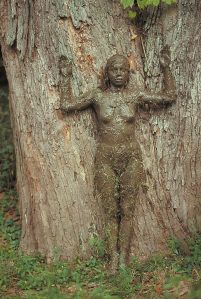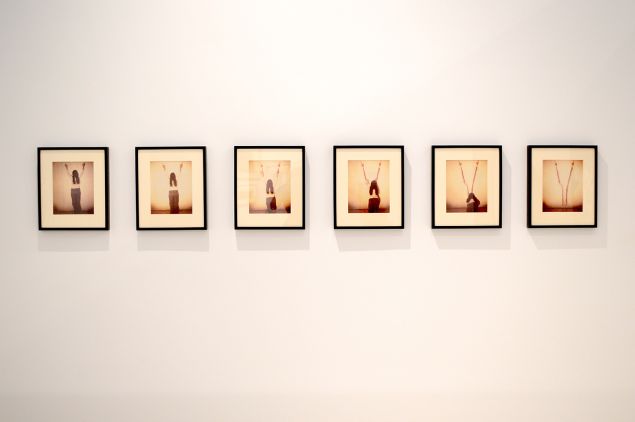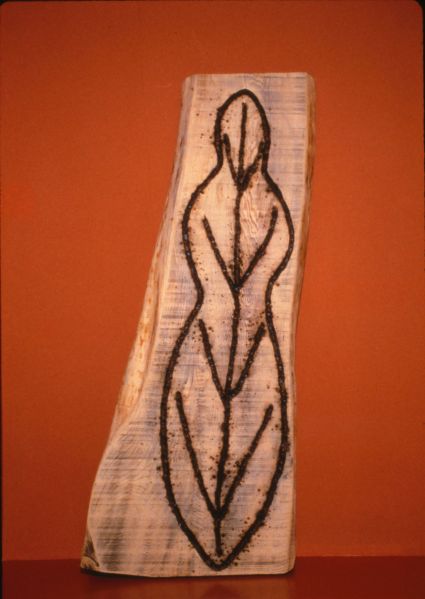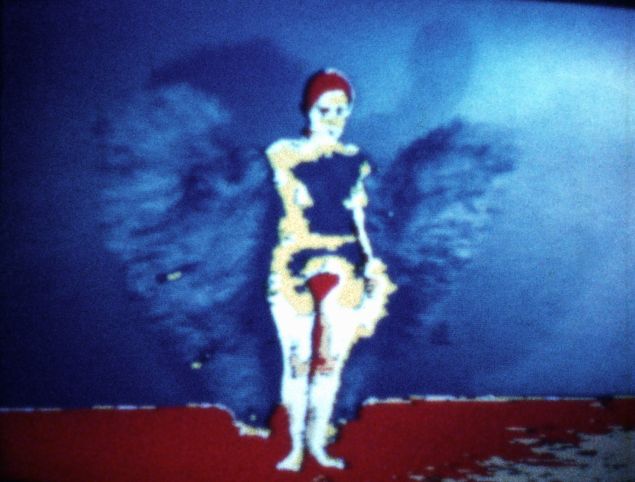
The first week of December, a mesmerizing body of artwork rarely seen and almost forgotten will go on display in Miami, at the public collection of Rosa de la Cruz, one of the country’s leading Contemporary art collectors. The pieces include images of the mud-smeared body of the artist; other works show her sweating blood from her pores. This dark imagery foretold her demise, some fans of the artist maintain.
On the 30-year anniversary of her death, a powerful cult is growing around photographer and filmmaker Ana Mendieta. Famous for some years mostly for the way she died, and forgotten for many more, her works are being rediscovered, exhibited around the U.S. and are climbing at auction. In the 1980s, if you could find a Mendieta, it was maybe $2,000, said Phillips auction house Worldwide Co-Head of Contemporary Art August Uribe. Now the median price for a Mendieta is $40,000 to $50,000, he said, and one hit a record of $200,000 at Phillips.
So, what’s fueling the rediscovery? In part, “I think that there is a renewed or new interest in the work of women artists [overall],” he said, and some of the new collectors of this work are women, he noted. It’s also because of the “globalization and internationalization” of the art world, he added. But with Mendieta specifically, it’s “the quality of the work,” Mr. Uribe said. “And her story.”
What is that story? In brief, the young and promising Cuban-American artist fell to her death in September 1985 from the 34th-floor window of her Greenwich Village apartment; her newlywed husband, legendary sculptor Carl Andre, was indicted, tried and eventually acquitted of her murder. His defense attorney argued, among other points, that Mendieta had committed “sub-intentional suicide.”
A sordid art world mystery at the time that polarized well-regarded art world principals on both sides, Ana Mendieta’s backstory is, finally, being overshadowed by her growing artistic legacy. It may have taken the art establishment years to find her work, but once it did, the response was what Mendieta seems to inspire, generally: devotion, even obsession.

Ms. de la Cruz estimates that, at 24 artworks, she is probably the largest single owner of Mendieta works outside the artist’s family. Ms. de la Cruz has created with her husband a personal museum, the Cruz Collection, and will show her Mendieta works at in an exhibit called “You’ve Got to Know the Rules to Break Them,” opening December 1 in Miami, in conjunction with the Art Basel Miami Beach fair. And that’s at least the third show to feature significant portions of Mendieta’s work in just the last two years.
This one will look at Mendieta as a symbol of American art—and its rule-breaking—during her peak. “When we found out about her work, she didn’t have an estate,” recalled Ms. de la Cruz, a fellow Cuban. “We were really wanting her work, because…it’s all about the healing nature of Mother Earth, the healing power of the female body.” But she not only liked Mendieta’s art and thought it was important, she was sure that interest in it would soon grow.
“I knew her work was going to be important historically,” Ms. de la Cruz said. “I think Mendieta has influenced a lot of artists,” the hugely influential collector noted, pointing to Tracey Emin and Rachel Harrison. Yet “very seldom do you see her work.”
Who was Ana Mendieta?
Ana Mendieta, an émigré from Cuba who had endured a difficult childhood—her father was reportedly jailed by Fidel Castro for treason—used her own body as a major component of her artwork. Her films and photos often used her sometimes naked form as subject and many had deep, earthy, bold colors and natural but stark shapes and elements. She used sticks and blood and dirt and plants. Her work has the feeling of a pagan ritual. It is somehow both haunting and life-affirming. And it appears to resonate with more and more collectors, as hard to collect as it is. In many ways, the work was ahead of its time.
‘My art is grounded in the belief of one universal energy which runs through everything.’—Ana Mendieta
“My art is grounded in the belief of one universal energy which runs through everything: from insect to man, from man to spectre, from spectre to plant, from plant to galaxy,” Mendieta wrote, according to the Feminist Art Archive at the University of Washington.
“There are very few women,” at a certain level in the art world, said Richard Move, a curator who made the 2009 film BloodWork: The Ana Mendieta Story. “There’s no [female] Damien Hirst. It’s even worse for ethnic women. And it hasn’t really changed at all.”
To many in the couple’s social circle, her death was not just a terrible mishap, but a symbol of the fate of so much feminist work and feminist women: marginalized, overlooked and too quickly forgotten. “Mendieta became emblematic of the male-dominated art world,” Mr. Move told the Observer.
On September 9, in a tony gallery off Madison Avenue, the floor sculptures of Carl Andre were arranged around work of many of his legendary contemporaries, such as John Chamberlain, Donald Judd, Sol LeWitt, Brice Marden, Robert Ryman and Frank Stella for a posh opening showcasing his work alongside other legendary American artists.
Although he was out of the spotlight for a spell following his trial, Mr. Andre, who turned 80 earlier this fall, has held, even cemented, his space as one of the most important American sculptors ever in the intervening years. Known for his elegant geometric tile works and for pioneering the Minimalism movement in sculpture, his work is in the permanent collections many of the world’s major museums, sells for millions at auction, appears unfailingly in all major art history texts, and his face is well-known.

More surprising has been Mendieta’s ascent. As identity politics and feminism have become more prevalent themes in art, and as word of her powerful story has spread, her renown has grown, albeit in fits and starts.
Of a 2004 exhibition, The New York Times’ critic Holland Cotter wrote: Ana Mendieta “comes through as the alert, ambitious artist she was, one who absorbed and acted on a wide range of ideas: aesthetic, ethnic, sexual, religious, political. Her best images, like one in which her nude body seems to be growing flowers, are of death and transfiguration, and they have the heartbreaking writ-on-water sting of fine poems.”
In 1987, the New Museum in New York gave Mendieta her first career retrospective. Later, shows in Helsinki, Spain and at the Hayward Gallery in London would follow. This September, eerily the same week as Mr. Andre’s show opened in New York, her dealer, Galerie Lelong, held a remembrance ceremony on the 30th anniversary of Mendieta’s death. There, Mary Sabbatino, a vice president and partner at Lelong, who helped put together the event with Mendieta’s niece Raquel Cecilia, talked about the wave of interest.
“No one could have known” how interest in her would continue to spike for the next 30 years, Ms. Sabbatino said. But Mendieta’s sister, Raquelin Mendieta, always prepared as though it would. She kept everything that belonged to her sister from the apartment at the time of her death, Ms. Sabbatino said. This impulse proved useful as her fame grew.
“She took every stitch” from Mendieta’s apartment, Ms. Sabbatino told the Observer, even old American Express bills. “She always knew Ana would be famous. She carried [her things] for so many years before anyone was interested.”
‘I knew her work was going to be important historically,’ said leading collector Rosa de la Cruz, who, with 24 Mendietas, has the largest trove.
In fact, many films Mendieta made had never been seen, because separate films were stored on the same reels and they had been in storage, Ms. Cecilia said. Now they are being shown, and Mendieta’s filmmaking has been revealed as an under-explored facet of the artist’s oeuvre. Ms. Cecilia, herself a filmmaker who was close to her aunt, recently had all 104 Mendieta films transferred to digital, which allowed her to help develop the exhibition “Covered in Time and History: The Films of Ana Mendieta.” The show opened this year at the Katherine E. Nash Gallery in Minneapolis and runs through December.
“We didn’t know she had created this huge body of work,” Ms. Cecilia said. “It’s a gift,” she said, of working on the project. “I get to be with her.”
The film trove is set to travel to Fort Lauderdale and Berkeley, Calif., and Galerie Lelong plans another show of Mendieta’s most experimental films opening Feb. 5, 2016. Those can now be contextualized alongside avant-garde filmmakers like Stan Brakhage who used similar methods, such as scarring and treating the physical film.
But even as her stock as an artist crescendos, many are still asking questions about Mendieta’s death.
The tragedy was as divisive as it was shocking.
In the days following his third wife’s death, Mr. Andre had the art world establishment rally for him. Supporters included the de Menils, the oil industrialist family behind the Minimalist-friendly Dia Foundation, and fellow artist Frank Stella, who offered to make hundreds of thousands of dollars available for Mr. Andre’s bail. The artist’s supporters resembled his work: staunch, composed and flawless. Ms. Mendieta’s supporters, on the other hand—whose ranks have grown over the last 30 years—were messier, much like her work. They included prominent performers like Carolee Schneemann, a standard-bearer for feminist artists, essentially. Schneeman’s most well-known work involves her pulling a scroll from her vagina, which she then read.
Sure that her sister would eventually become famous, Raquelin Mendieta saved everything,
from clothing to credit card bills.
The specifics of the case have been reiterated many times over the years, though with no eye-witnesses save perhaps Mr. Andre, many details remain unclear. He said his wife—who stood about five feet tall and was petrified of heights, according to Ms. Schneemann, a close friend—had “gone out the window.” Mr. Andre had scratch marks on his body and his story as told to the police and to emergency dispatch reportedly conflicted (although this is not uncommon in the case of violent deaths). According to a tape of his September 1985 call to 911, as reported by The New York Times: “We had a quarrel about the fact that I was more, eh, exposed to the public than she was. And she went to the bedroom, and I went after her, and she went out the window.”
The sculptor’s defense attorney, Jack Hoffinger, reached at his home, said, “The case against Carl Andre was more than weak; it just didn’t exist. It was a case that was played up in the press and became somewhat of a feminist issue.” (The prosecutor was Elizabeth Lederer, now a lecturer at Columbia University, who did not return emails seeking comment and could not be reached through the University or the District Attorney’s office.)
The unusual trial was adjudicated only by a judge, not a jury, at the request of Mr. Andre’s lawyer, which is his client’s right. “I wanted to avoid dealing with a jury of women that might possibly be swayed by the so-called feminist issue,” Mr. Hoffinger said.

Alcohol and the role it may have played became an important question in the trial, according to contemporary reports. Mendieta had always had a temper. Her marriage was thought to be stormy, and both she and Mr. Andre were known to drink heavily and often, said Judd Tully, an editor at Art+Auction magazine and prominent art world chronicler, who covered the Andre trial.
But while Mendieta may have been emotional and impulsive, the idea that she had killed herself was anathema for many of her friends and associates. Indeed, if anything, she had reason to be hopeful at the time of her death. A winner of a Guggenheim Fellowship, her work had also just showed up on the art world radar. “Her star was rising,” when she died, Mr. Tully said.
The matter dragged on and the 1988 acquittal split the art world. Ted Victoria, an artist and close friend of Mendieta, told the Guardian simply, “The notion that she would jump out the window in her underwear—no.”
“She was volatile,” Ms. Schneemann told the Observer. “That would have been extremely disruptive and demanding [to Mr. Andre],” Ms. Schneemann said, who remains suspicious. Mr. Andre’s previous dealer, Angela Westwater, however, later told The New Yorker she was sure the event was simply a tragic accident. (Paula Cooper, Mr. Andre’s dealer now, declined to comment for this story, as did the sculptor.)
The Guerrilla Girls, an anonymous art collective of women who wear gorilla masks when they appear in public, were some of the more vocal critics of Mr. Andre and the peer group that defended him (and, often, bought, sold and supported his work).
“While powerful white people in the art world defended Andre, we bet that, to a one, they considered O.J. [Simpson] guilty,” the Guerilla Girls told the Observer via email. While the group notes it has never accused either man of murder, they believe both to be domestic abusers. “Some of our early members knew Ana. We were all stunned by her violent death. We witnessed how the art world closed around Andre to shield him.”
‘We had a quarrel about the fact that I was more, eh, exposed to the public than she was,’ Carl Andre said immediately after his wife’s fall, according to the 1985 tape of his 911 call. ‘And she went to the bedroom, and I went after her, and she went out the window.’
Mr. Andre kept a low profile in the months, even years, following the trial, reportedly spending time in Europe, where he sold a significant amount of work.
“It was my understanding at the time that Carl Andre put out a command that no one should come out to the trial and see him in that position,” said Mr. Tully. “He sort of made himself scarce after this for many years.”

When he did return to the art world, he easily took back his mantle, though his past was never fully behind him. In 1992, his work was featured at the Solomon R. Guggenheim’s museum’s downtown satellite. But protesters carrying signs asking, “Where is Ana Mendieta?” confronted visitors. And last year, the Dia Art Foundation gave him a massive show, entitled “Carl Andre: Sculpture as Place”; protests, including a “cry-in” for Mendieta, were held outside.
Christen Clifford, a feminist artist and the head of the protest performance group We Wish Ana Mendieta Were Still Alive, who helped arrange the cry-in, said: “I love her work so much and it has been so important to me. I’m someone who was raped and I looked to her as a way of understanding my place in the world. When I saw Andre has a piece on the cover of Artforum I was like, ‘what the fuck?’…And I saw that the show was happening at Dia and I was just really, really mad. I got people from my feminist performance group to do a public action.”
Twenty years on, Ms. Cecilia says remembrances for her aunt no longer have a mourning quality, but have transformed into “celebrations.” And she said she doesn’t have an opinion either way when people protest Mr. Andre’s shows. “It’s their choice.”
Said Ms. de la cruz, of one of her favorite artists, on the eve of the exhibition: “Unfortunately, Ana Mendieta died very young. She was only 36. Her sustained influence continues on art students and artists today.”
Meanwhile, the exhibit at Mnuchin Gallery, “Carl Andre in his Time,” premiered to rave reviews. The show is up till December 5.

